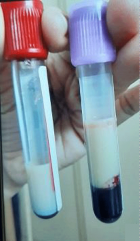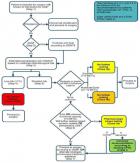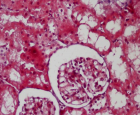Abstract
Research Article
Improving the Concrete Compressive and Flexural Strength with a Low Fraction Addition of Carboxylated Nitro-oxidized Cellulose Nanofibrils from Banana Rachis
Ngesa Ezekiel Mushi* and Emmanuel Kagya
Published: 17 September, 2024 | Volume 8 - Issue 1 | Pages: 087-095
Conventionally, concrete strength depends on the bonding interface, especially in hydrated products such as calcium silicate hydrate (CSH). As a result, concrete is sensitive under tensile load. With its unique properties, a low fraction of carboxylated nitro-oxidized cellulose nanofibrils (NOCNF) from the banana rachis is employed to improve the mechanical performance of the concrete nano structurally. Compressive and flexural strength using the NOCNF content at 0, 0.05, and 0.1 wt. % cured in 7 and 28 days were evaluated. Notably, the compressive strength increased by 16% and flexural strength by 13% at 0.1% NOCNF compared to plain concrete after the 28 curing days. A low NOCNF fraction achieved a good, albeit impossible, performance with the microscale fibers. The nanostructured effect was discussed twofold: an excellent interaction between the NOCNF and the hydrated products and the carboxylic groups on the NOCNF surface enhanced the cement hydration. These data are better than the literature based on the small-diameter cellulose nanofibrils without the carboxyl groups. As a sustainable nanocomponent, NOCNF could be a perfect candidate to improve concrete performance under mechanical load.
Read Full Article HTML DOI: 10.29328/journal.acee.1001072 Cite this Article Read Full Article PDF
Keywords:
Banana rachis; Concrete; Carboxylated nitro-oxidized cellulose nanofibrils; Compressive strength; Flexural strength
References
- McCarthy MJ, Dyer TD. Pozzolanas and pozzolanic materials. In: Lea’s Chemistry of Cement and Concrete. 5th ed. Amsterdam: Elsevier. 2019;363-467. Available from: https://discovery.dundee.ac.uk/en/publications/pozzolanas-and-pozzolanic-materials
- Ramachandran VS, Beaudoin JJ. Handbook of analytical techniques in concrete science and technology: principles, techniques, and applications. Amsterdam: Elsevier; 2000. Available from: https://shop.elsevier.com/books/handbook-of-analytical-techniques-in-concrete-science-and-technology/ramachandran/978-0-8155-1437-4
- Callister Jr WD. Materials science and engineering: an introduction. 7th ed. New York: Wiley; 2007. Available from: https://www.amazon.in/Materials-Science-Engineering-Introduction-Wiley/dp/0470120320
- Mostafa M, Uddin N. Experimental analysis of Compressed Earth Block (CEB) with banana fibers resisting flexural and compression forces. Case Studies in Construction Materials. 2016;5:53-63. Available from: https://doi.org/10.1016/j.cscm.2016.07.001
- Hisseine OA, Wilson W, Sorelli L, Tolnai B, Tagnit-Hamou A. Nanocellulose for improved concrete performance: A macro-to-micro investigation for disclosing the effects of cellulose filaments on strength of cement systems. Construction and Building Materials. 2019;206:84-96. Available from: https://doi.org/10.1016/j.conbuildmat.2019.02.042
- El-Feky MS, El-Tair AM, Kohail M, Serag MI. Nano-Fibrillated Cellulose as a Green Alternative to Carbon Nanotubes in Nano Reinforced Cement Composites. International Journal of Innovative Technology and Exploring Engineering. 2019;8(12):2278-3075. Available from: https://www.ijitee.org/wp-content/uploads/papers/v8i12/L33771081219.pdf
- Cengiz A, Kaya M, Bayramgil NP. Flexural stress enhancement of concrete by incorporation of algal cellulose nanofibers. Construction and Building Materials. 2017;149:289-95. Available from: http://dx.doi.org/10.1016/j.conbuildmat.2017.05.104
- Rahimi-Aghdam S, Bažant ZP, Qomi MA. Cement hydration from hours to centuries controlled by diffusion through barrier shells of CSH. Journal of the Mechanics and Physics of Solids. 2017;99:211-24. Available from: https://doi.org/10.1016/j.jmps.2016.10.010
- Barnat-Hunek D, ska-Chargot MS, Jarosz-Hadam M, Łagód G. Effect of cellulose nanofibrils and nanocrystals on physical properties of concrete. Construction and Building Materials. 2019;223:1-11. Available from: https://doi.org/10.1016/j.conbuildmat.2019.06.145
- Senthilkumar K, Siva I, Rajini N, Jappes JW, Siengchin S. Mechanical characteristics of tri-layer eco-friendly polymer composites for interior parts of aerospace application. In: Sustainable composites for aerospace applications. Amsterdam: Elsevier. 2018;35-53. Available from: http://dx.doi.org/10.1016/B978-0-08-102131-6.00003-7
- Moon RJ, Martini A, Nairn J, Simonsen J, Youngblood J. Cellulose nanomaterials review: structure, properties, and nanocomposites. Chemical Society Reviews. 2011;40(7):3941-94. Available from: https://pubs.rsc.org/en/content/articlelanding/2011/cs/c0cs00108b
- Vincent JF, Wegst UG. Design and mechanical properties of insect cuticle. Arthropod Structure & Development. 2004;33(3):187-99. Available from: https://doi.org/10.1016/j.asd.2004.05.006
- Florian TDM, Villani N, Aguedo M, Jacquet N, Thomas HG, Gerin P, et al. Chemical composition analysis and structural features of banana rachis lignin extracted by two organosolv methods. Industrial Crops and Products. 2019;132:269-74. Available from: https://dial.uclouvain.be/pr/boreal/object/boreal%3A214867/datastream/PDF_01/view
- Zuluaga R, Putaux JL, Cruz J, Vélez J, Mondragon I, Gañán P. Cellulose microfibrils from banana rachis: Effect of alkaline treatments on structural and morphological features. Carbohydrate Polymers. 2009;76(1):51-9. Available from: https://doi.org/10.1016/j.carbpol.2008.09.024
- Sharma PR, Joshi R, Sharma SK, Hsiao BS. A simple approach to prepare carboxycellulose nanofibers from untreated biomass. Biomacromolecules. 2017;18(8):2333-42. Available from: https://doi.org/10.1021/acs.biomac.7b00544
- Chen H, Chi K, Cao R, Sharma SK, Bokhari SM, Johnson KI, et al. Nitro-oxidation process for fabrication of efficient bioadsorbent from lignocellulosic biomass by combined liquid-gas phase treatment. Carbohydrate Polymer Technologies and Applications. 2022;3:100219. Available from: https://doi.org/10.1016/j.carpta.2022.100219
- Aïtcin P-C, Flatt RJ. Science and technology of concrete admixtures. Cambridge: Woodhead Publishing; 2015. Available from: https://shop.elsevier.com/books/science-and-technology-of-concrete-admixtures/aitcin/978-0-08-100693-1
- Gligorovski S, Strekowski R, Barbati S, Vione D. Environmental implications of hydroxyl radicals (• OH). Chemical Reviews. 2015;115(24):13051-92. Available from: https://doi.org/10.1021/cr500310b
- Rwegasila E, Li L, Berglund LA, Mushi NE. Strong nanostructured film and effective lead (II) removal by nitro-oxidized cellulose nanofibrils from banana rachis. Cellulose. 2024;31(5):1-17. Available from: http://dx.doi.org/10.1007/s10570-024-05749-4
- International Organization for Standardization. Testing of concrete Part 3: Making and curing test specimens, ISO 1920. 2019. Available from: https://standards.iteh.ai/catalog/standards/iso/50dfd126-fd36-48c6-91d0-c3205fe2d4d8/iso-1920-3-2019?srsltid=AfmBOoqCGUljuxIj9MXyuQr5im8p13G5ItjrhVdC5CG_2C6M-rx8Tk7P
- Lyons A. Materials for architects and builders. 3rd ed. Oxford: Butterworth-Heinemann; 2007. Available from: https://doi.org/10.4324/9780080465791
- International Organization for Standardization. Testing of concrete — Part 4: Strength of hardened concrete, ISO https://cdn.standards.iteh.ai/samples/72260/a32f5d2f674047459842b873435fe9ee/ISO-1920-4-2020.pdf
- Hisseine OA, Omran AF, Tagnit-Hamou A. Influence of cellulose filaments on cement pastes and concrete. Journal of Materials in Civil Engineering. 2018;30(6). Available from: http://dx.doi.org/10.1061/%28ASCE%29MT.1943-5533.0002287
- Onuaguluchi O, Panesar D, Sain M. Properties of nanofibre reinforced cement composites. Construction and Building Materials. 2014;63:119-24. Available from: https://doi.org/10.1016/j.conbuildmat.2014.04.072
- Long W, Wang Y. Effect of pine needle fibre reinforcement on the mechanical properties of concrete. Construction and Building Materials. 2021;278:122333. Available from: https://doi.org/10.1016/j.conbuildmat.2021.122333
- Kolias S, Georgiou C. The effect of paste volume and of water content on the strength and water absorption of concrete. Cement and Concrete Composites. 2005;27(2):211-6. Available from: http://dx.doi.org/10.1016%2Fj.cemconcomp.2004.02.009
- Cao Y, Zavaterri P, Youngblood J, Moon R, Weiss J. The influence of cellulose nanocrystal additions on the performance of cement paste. Cement and Concrete Composites. 2015;56:73–83. Available from: https://doi.org/10.1016/j.cemconcomp.2014.11.008
- Flores J, Kamali M, Ghahremaninezhad A. An investigation into the properties and microstructure of cement mixtures modified with cellulose nanocrystal. Materials. 2017;10(5):498. Available from: https://doi.org/10.3390/ma10050498
- Peters SJ, Rushing TS, Landis EN, Cummins TK. Nanocellulose and Microcellulose Fibers for Concrete. Transportation Research Record. 2010;2142:25–8. Available from: http://dx.doi.org/10.3141/2142-04
- Nishiyama Y, Langan P, Chanzy H. Crystal structure and hydrogen-bonding system in cellulose Iβ from synchrotron X-ray and neutron fiber diffraction. Journal of the American Chemical Society. 2002;124(31):9074-82. Available from: https://doi.org/10.1021/ja0257319
- Guan W, Ji F, Chen Q, Yan P, Pei L. Synthesis and enhanced phosphate recovery property of porous calcium silicate hydrate using polyethyleneglycol as pore-generation agent. Materials. 2013;6(7):2846-61. Available from: https://doi.org/10.3390/ma6072846
- Mohammadkazemi F, Doosthoseini K, Ganjian E, Azin M. Manufacturing of bacterial nano-cellulose reinforced fiber-cement composites. Construction and Building Materials. 2015;101:958-64. Available from: http://dx.doi.org/10.1016/j.conbuildmat.2015.10.093
- Bergold S, Goetz-Neunhoeffer F, Neubauer J. Quantitative analysis of C–S–H in hydrating alite pastes by in-situ XRD. Cement and Concrete Research. 2013;53:119-26. Available from: https://doi.org/10.1016/j.cemconres.2013.06.001
- Kezuka Y, Kawai K, Eguchi K, Tajika M. Fabrication of single-crystalline calcite needle-like particles using the aragonite–calcite phase transition. Minerals. 2017;7(8):133. Available from: http://dx.doi.org/10.3390/min7080133
- Kong L, Gao L, Du Y. Effect of coarse aggregate on the interfacial transition zone of concrete based on grey correlation. Magazine of Concrete Research. 2014;66(7):339-47. Available from: https://doi.org/10.1680/macr.13.00269
- Cherubini F. The biorefinery concept: Using biomass instead of oil for producing energy and chemicals. Energy Conversion and Management. 2010;51(7):1412-21. Available from: https://www.scirp.org/reference/referencespapers?referenceid=1864927
- Tanzania Social Action Fund (TASAF). The United Republic of Tanzania. President's Office-State House. Available from: https://www.tasaf.go.tz/pages/test
Figures:
Similar Articles
-
Effect of cement solidification on strength and leaching properties of Heavy Metals Contaminated SoilSyed Taseer Abbas Jaffar*,Sajjad Yousefi Oderji,Si-an Zhang,Long-zhu Chen. Effect of cement solidification on strength and leaching properties of Heavy Metals Contaminated Soil. . 2018 doi: 10.29328/journal.acee.1001011; 2: 016-027
-
Investigation and analysis of fracture failure and fatigue cracking in High-rise pavement using simulation software of ABAQUSSeyed Masoud Hadian*. Investigation and analysis of fracture failure and fatigue cracking in High-rise pavement using simulation software of ABAQUS. . 2019 doi: 10.29328/journal.acee.1001015; 3: 032-039
-
Climate and garbageKhalidullin Oleg*. Climate and garbage. . 2021 doi: 10.29328/journal.acee.1001027; 5: 001-002
-
The Effect of Cellulose Fiber on the Bending Strength of Autoclaved Aerated ConcreteSvitlana Lapovska, Nicholas Chernenko, Mykola Konoplya. The Effect of Cellulose Fiber on the Bending Strength of Autoclaved Aerated Concrete. . 2024 doi: 10.29328/journal.acee.1001065; 8: 045-047
-
Improving the Concrete Compressive and Flexural Strength with a Low Fraction Addition of Carboxylated Nitro-oxidized Cellulose Nanofibrils from Banana RachisNgesa Ezekiel Mushi*, Emmanuel Kagya. Improving the Concrete Compressive and Flexural Strength with a Low Fraction Addition of Carboxylated Nitro-oxidized Cellulose Nanofibrils from Banana Rachis. . 2024 doi: 10.29328/journal.acee.1001072; 8: 087-095
Recently Viewed
-
Non-surgical Treatment of Verrucous Hyperplasia on Amputation Stump: A Case Report and Literature ReviewSajeda Alnabelsi*, Reem Hasan, Hussein Abdallah, Suzan Qattini. Non-surgical Treatment of Verrucous Hyperplasia on Amputation Stump: A Case Report and Literature Review. Ann Dermatol Res. 2024: doi: 10.29328/journal.adr.1001034; 8: 015-017
-
Outpatient operative hysteroscopy: evaluation of patient satisfaction and acceptanceClare Margaret Crowley*,Noelle Gill,Minna Geisler. Outpatient operative hysteroscopy: evaluation of patient satisfaction and acceptance. Clin J Obstet Gynecol. 2022: doi: 10.29328/journal.cjog.1001098; 5: 005-008
-
Predictors of positive treatment response to PTNS in women with overactive bladderSuneetha Rachaneni*,Doyo Enki,Megan Welstand,Thomasin Heggie,Anupreet Dua. Predictors of positive treatment response to PTNS in women with overactive bladder. Clin J Obstet Gynecol. 2022: doi: 10.29328/journal.cjog.1001097; 5: 001-004
-
Prediction of neonatal and maternal index based on development and population indicators: a global ecological studySedigheh Abdollahpour,Hamid Heidarian Miri,Talat Khadivzadeh*. Prediction of neonatal and maternal index based on development and population indicators: a global ecological study. Clin J Obstet Gynecol. 2021: doi: 10.29328/journal.cjog.1001096; 4: 101-105
-
A Genetic study in assisted reproduction and the risk of congenital anomaliesKaparelioti Chrysoula,Koniari Eleni*,Efthymiou Vasiliki,Loutradis Dimitrios,Chrousos George,Fryssira Eleni. A Genetic study in assisted reproduction and the risk of congenital anomalies. Clin J Obstet Gynecol. 2021: doi: 10.29328/journal.cjog.1001095; 4: 096-100
Most Viewed
-
Evaluation of Biostimulants Based on Recovered Protein Hydrolysates from Animal By-products as Plant Growth EnhancersH Pérez-Aguilar*, M Lacruz-Asaro, F Arán-Ais. Evaluation of Biostimulants Based on Recovered Protein Hydrolysates from Animal By-products as Plant Growth Enhancers. J Plant Sci Phytopathol. 2023 doi: 10.29328/journal.jpsp.1001104; 7: 042-047
-
Sinonasal Myxoma Extending into the Orbit in a 4-Year Old: A Case PresentationJulian A Purrinos*, Ramzi Younis. Sinonasal Myxoma Extending into the Orbit in a 4-Year Old: A Case Presentation. Arch Case Rep. 2024 doi: 10.29328/journal.acr.1001099; 8: 075-077
-
Feasibility study of magnetic sensing for detecting single-neuron action potentialsDenis Tonini,Kai Wu,Renata Saha,Jian-Ping Wang*. Feasibility study of magnetic sensing for detecting single-neuron action potentials. Ann Biomed Sci Eng. 2022 doi: 10.29328/journal.abse.1001018; 6: 019-029
-
Pediatric Dysgerminoma: Unveiling a Rare Ovarian TumorFaten Limaiem*, Khalil Saffar, Ahmed Halouani. Pediatric Dysgerminoma: Unveiling a Rare Ovarian Tumor. Arch Case Rep. 2024 doi: 10.29328/journal.acr.1001087; 8: 010-013
-
Physical activity can change the physiological and psychological circumstances during COVID-19 pandemic: A narrative reviewKhashayar Maroufi*. Physical activity can change the physiological and psychological circumstances during COVID-19 pandemic: A narrative review. J Sports Med Ther. 2021 doi: 10.29328/journal.jsmt.1001051; 6: 001-007

HSPI: We're glad you're here. Please click "create a new Query" if you are a new visitor to our website and need further information from us.
If you are already a member of our network and need to keep track of any developments regarding a question you have already submitted, click "take me to my Query."



















































































































































